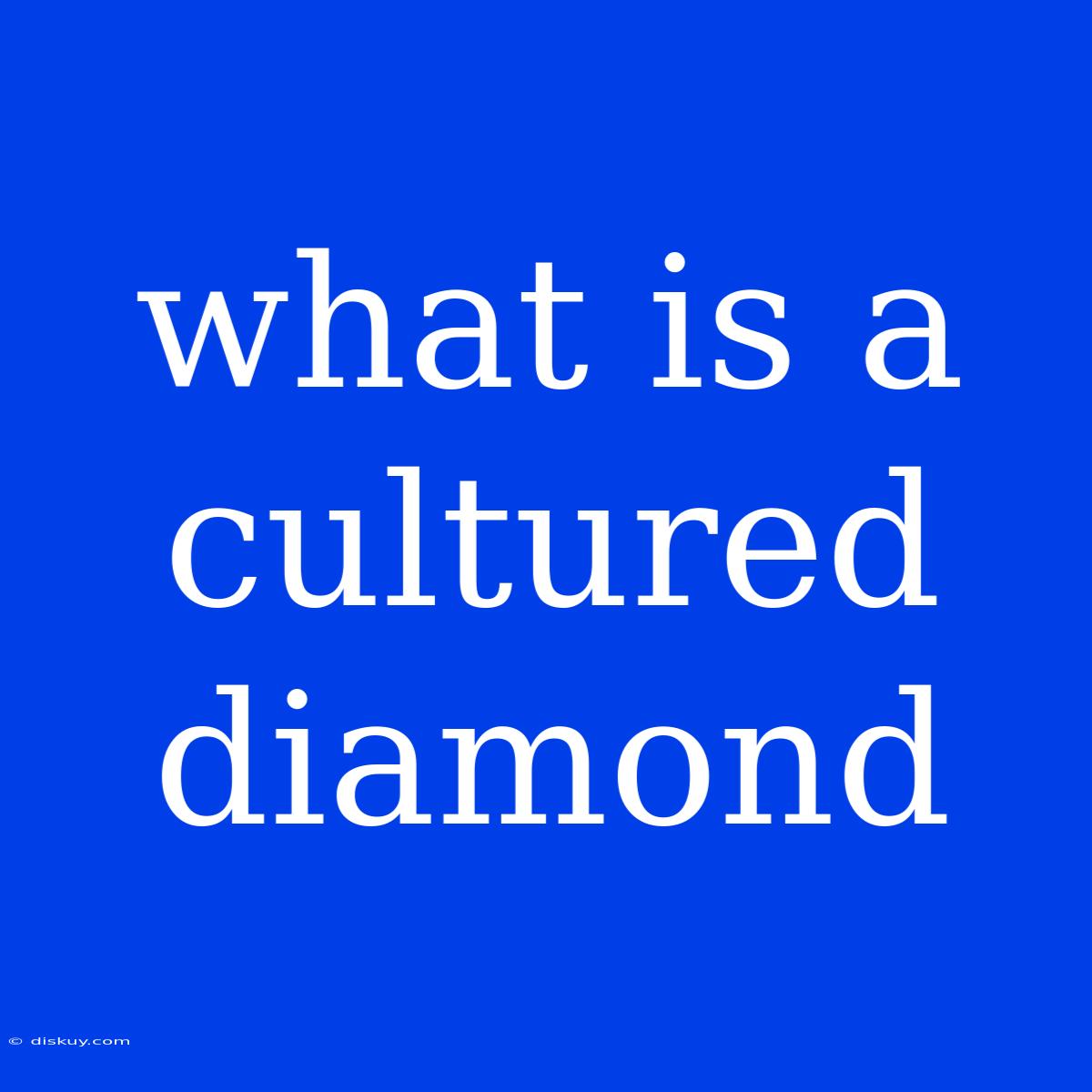What is a Cultured Diamond? The Truth Behind Lab-Grown Gems
Is a cultured diamond the same as a mined diamond? This question often arises when exploring the world of diamonds. While both share the same chemical composition and brilliance, they differ in their origin, which impacts their ethical and environmental footprint.
Editor Note: Cultured diamonds, also known as lab-grown diamonds, are gaining popularity as a sustainable alternative to mined diamonds. This article will delve into the fascinating process behind their creation, explore their unique properties, and discuss why they are an ethical and environmentally conscious choice.
Why is this topic important? The diamond industry has been a subject of scrutiny due to concerns over labor practices, environmental impact, and conflict diamonds. Cultured diamonds offer a solution by providing ethically sourced, environmentally responsible, and affordable alternatives, making them an increasingly attractive choice for conscious consumers.
Our analysis: To understand the intricacies of cultured diamonds, we conducted extensive research, delving into scientific literature, industry reports, and expert opinions. We meticulously compared the characteristics of cultured diamonds with mined diamonds, uncovering key differences and similarities, and highlighting the advantages and considerations of choosing lab-grown diamonds.
Key Takeaways:
| Feature | Cultured Diamonds | Mined Diamonds |
|---|---|---|
| Origin | Grown in a lab | Extracted from the earth |
| Composition | Same as mined diamonds | Same as cultured diamonds |
| Chemical Structure | Identical | Identical |
| Price | Generally more affordable | Typically more expensive |
| Ethical Impact | Sustainable and ethical | Concerns over labor practices |
| Environmental Impact | Minimal footprint | Significant environmental impact |
Cultured Diamond: A Detailed Look
The Science Behind Creation
Cultured diamonds are created through a sophisticated process called High Pressure/High Temperature (HPHT) synthesis. In this method, pure carbon, in the form of graphite, is subjected to intense heat (1573°C) and pressure (5.5 GPa) in a controlled lab environment, mimicking the conditions deep within the earth where natural diamonds form. This process leads to the crystallization of carbon atoms into a diamond lattice, creating a gem indistinguishable from a mined diamond.
Distinctive Characteristics
Cultured diamonds possess the same physical and optical properties as their mined counterparts. They exhibit unparalleled brilliance, fire, and scintillation, reflecting light with captivating beauty.
Ethical and Environmental Considerations
Choosing a cultured diamond presents numerous advantages in terms of ethical and environmental responsibility. Their creation involves minimal environmental impact compared to the extensive mining operations required for mined diamonds. Additionally, cultured diamonds eliminate the concerns associated with conflict diamonds and ensure ethical sourcing practices.
Key Aspects
- Carbon source: The choice of carbon source influences the quality and purity of the cultured diamond.
- Growth process: The HPHT synthesis technique plays a crucial role in the final quality and characteristics of the diamond.
- Certification: Reputable labs like the Gemological Institute of America (GIA) and the American Gem Society (AGS) issue certifications for cultured diamonds, guaranteeing their authenticity and quality.
The Growing Popularity of Cultured Diamonds
The increasing awareness of the ethical and environmental implications of the diamond industry has led to a surge in the popularity of cultured diamonds. Consumers are increasingly embracing these lab-grown gems as a responsible and sustainable alternative, without compromising on quality or beauty.
FAQ
1. Are cultured diamonds real diamonds?
Yes, cultured diamonds are real diamonds, sharing the same chemical composition and physical properties as mined diamonds.
2. How can I tell the difference between a cultured and a mined diamond?
Determining the origin of a diamond requires specialized equipment and expertise. Gemologists use advanced techniques, such as infrared spectroscopy, to differentiate between cultured and mined diamonds.
3. Are cultured diamonds less valuable than mined diamonds?
While cultured diamonds may be more affordable, their value is increasing as their popularity grows.
4. Do cultured diamonds last as long as mined diamonds?
Yes, cultured diamonds are just as durable as mined diamonds, exhibiting the same hardness and resistance to scratches and wear.
5. Are cultured diamonds ethically sourced?
Yes, cultured diamonds are ethically sourced, eliminating the concerns associated with conflict diamonds and ensuring sustainable practices.
6. Are cultured diamonds environmentally friendly?
Yes, cultured diamonds are significantly more environmentally friendly than mined diamonds, with a minimal carbon footprint and limited impact on natural resources.
Tips for Choosing Cultured Diamonds
- Choose a reputable supplier: Look for vendors with a proven track record and transparent practices.
- Check for certification: Ensure the diamond comes with a certification from a renowned gemological lab, such as GIA or AGS.
- Understand the characteristics: Consider the diamond's cut, clarity, color, and carat weight based on your preferences and budget.
- Ask questions: Don't hesitate to inquire about the diamond's origin, growth process, and ethical sourcing practices.
Summary
Cultured diamonds offer a compelling alternative to mined diamonds, presenting a sustainable and ethical solution for conscious consumers. They possess the same brilliance and durability as mined diamonds while mitigating the environmental and ethical concerns associated with traditional diamond mining. As the demand for ethically sourced and environmentally responsible choices continues to rise, cultured diamonds are poised to play an increasingly significant role in the diamond industry.
Closing Message: The diamond industry is evolving, and cultured diamonds are at the forefront of this transformation. By embracing these lab-grown gems, we can contribute to a more sustainable and ethical future, while still enjoying the beauty and allure of diamonds.

